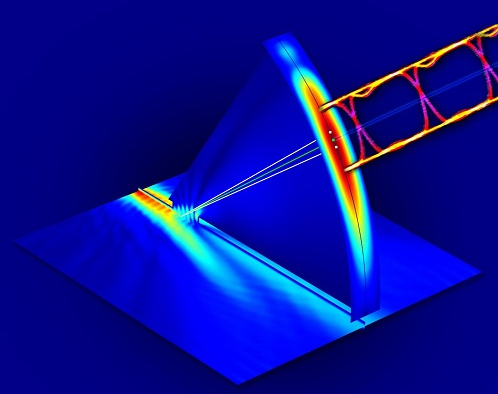
Data Transmission via Terahertz Multiplexer
source:photonics
release:Nick
keywords: Data Transmission; multiplexing data; demultiplexing
Time:2017-08-16
Numerical simulation of terahertz waves being emitted from the new multiplexer device. Courtesy of Mittleman Lab/Brown University.
Researchers from Brown University report the transmission of two real-time video signals through a terahertz multiplexer at an aggregate data rate of 50 gigabits per second. This is approximately 100 times the optimal data rate of today's fastest cellular network.
"We showed that we can transmit separate data streams on terahertz waves at very high speeds and with very low error rates," said Daniel Mittleman, a professor in Brown's School of Engineering. "This is the first time anybody has characterized a terahertz multiplexing system using actual data, and our results show that our approach could be viable in future terahertz wireless networks."
Current voice and data networks use microwaves to carry signals wirelessly. But the demand for data transmission is quickly becoming more than microwave networks can handle. Terahertz waves have higher frequencies than microwaves and therefore a much larger capacity to carry data. However, scientists have only just begun experimenting with terahertz frequencies, and many of the basic components necessary for terahertz communication don't exist yet.
A system for multiplexing and demultiplexing — also known as mux/demux — allows one cable to carry multiple TV channels or hundreds of users to access a wireless Wi-Fi network. The mux/demux approach Mittleman and his colleagues developed uses two metal plates placed parallel to each other to form a waveguide. One of the plates has a slit cut into it. When terahertz waves travel through the waveguide, some of the radiation leaks out of the slit. The angle at which radiation beams escape is dependent upon the frequency of the wave.
"We can put several waves at several different frequencies — each of them carrying a data stream — into the waveguide, and they won't interfere with each other because they're different frequencies; that's multiplexing," said Mittleman. "Each of those frequencies leaks out of the slit at a different angle, separating the data streams; that's demultiplexing."
Because of the nature of terahertz waves, signals in terahertz communications networks will propagate as directional beams, not omnidirectional broadcasts like in existing wireless systems. This directional relationship between propagation angle and frequency is the key to enabling mux/demux in terahertz systems. A user at a particular location will communicate on a particular frequency.
Working with Guillaume Ducournau at Institut d'Electronique de Microélectronique et de Nanotechnologie, CNRS/University of Lille, in France, the researchers encoded two high-definition television broadcasts onto terahertz waves of two different frequencies: 264.7 GHz and 322.5 GHz. They then beamed both frequencies together into the multiplexer system, with a television receiver set to detect the signals as they emerged from the device. When the researchers aligned their receiver to the angle from which 264.7-GHz waves were emitted, they saw the first channel. When they aligned with 322.5 GHz, they saw the second.
Further experiments showed that transmissions were error-free up to 10 gigabits per second, which is much faster than today's standard Wi-Fi speeds.
In addition to demonstrating that the device worked, Mittleman says the research revealed some surprising details about transmitting data on terahertz waves. When a terahertz wave is modulated to encode data, the main wave is accompanied by sideband frequencies that also must be detected by a receiver in order to transmit all the data. The research showed that the angle of the detector with respect to the sidebands is important to keeping the error rate down.
The researchers plan to continue developing this and other terahertz components. Mittleman recently received a license from the FCC to perform outdoor tests at terahertz frequencies on the Brown University campus.
- RoboSense is to Produce the First Chinese Multi-beam LiDAR
- China is to Accelerate the Development of Laser Hardening Application
- Han’s Laser Buys Canadian Fiber Specialist CorActive
- SPI Lasers continues it expansion in China, appointing a dedicated Sales Director
- Laser Coating Removal Robot for Aircraft
 FISBA exhibits Customized Solutions for Minimally Invasive Medical Endoscopic Devices at COMPAMED in
FISBA exhibits Customized Solutions for Minimally Invasive Medical Endoscopic Devices at COMPAMED in New Active Alignment System for the Coupling of Photonic Structures to Fiber Arrays
New Active Alignment System for the Coupling of Photonic Structures to Fiber Arrays A new industrial compression module by Amplitude
A new industrial compression module by Amplitude Menhir Photonics Introduces the MENHIR-1550 The Industry's First Turnkey Femtosecond Laser of
Menhir Photonics Introduces the MENHIR-1550 The Industry's First Turnkey Femtosecond Laser of Shenzhen DNE Laser introduced new generation D-FAST cutting machine (12000 W)
more>>
Shenzhen DNE Laser introduced new generation D-FAST cutting machine (12000 W)
more>>


